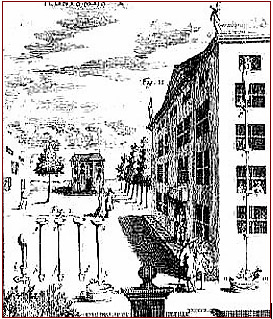THE FIRST BAROMETER & SOME SORCERY :
In 1641, the Italian
physician and mathematician Evangelista Torricelli moved to
Florence
to assist the father of
modern science and physics, Galileo Galilei.
They worked together for only
one year before Galileo’s death in 1642.
Torricelli applied what he
had learned from Galileo to construct history's first
barometer,
using water to measure air
pressure.
However, as water is
not a heavy liquid, the barometer measured almost 35 feet high -
rising through the roof of
his home.
He placed a figural buoy on top of
the water to more easily observe the changes.
Needless to say, as
the figure rose and fell with the pressure,
his
neighbors noticed his three-story experiment.

Rumors began to circulate through the neighborhood that
Torricelli must be practicing sorcery.
Torricelli realized he must quickly change the experiment - or
risk being arrested.
From a previous suggestion by Galileo, Torricelli decided upon
mercury as the solution.
Mercury is 14 times heavier than water, and remains in a liquid
state at normal temperatures.
Thus the glass container needed only to be 32 inches tall!
The "Torricelli Tube" was invented --
and the scientist could continue his experiments in the privacy
of his own home,
with a much-reduced risk of arrest.